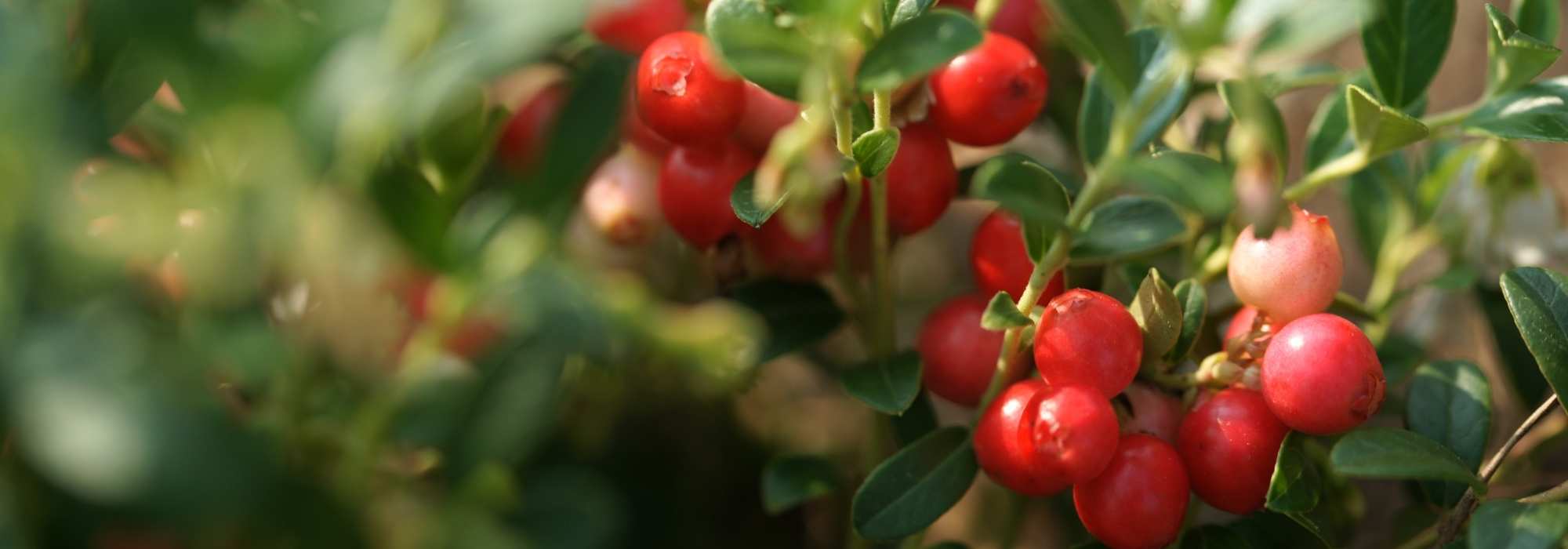
Cranberry: planting, harvest, benefits
Contents
Cranberry in a nutshell
- Cranberry is a small shrub cultivated for its edible, tangy red berries, cranberries
- Cooked, dried, or as juice, cranberry lends itself to many recipes
- The berries have a pleasantly tangy taste, somewhat sour, and offer numerous benefits
- It is the plant for urinary comfort!
- This small groundcover shrub thrives in partial shade and in acidic, moist soils
A word from our expert
Famous for naturally combating urinary infections, the Cranberry (Vaccinium macrocarpon) is a small groundcover fruit bush that reaches a height of 30 cm, making it a great addition to our orchards! In autumn, it produces small, edible red berries – cranberries – with a deliciously tangy flavour. Enjoy fresh or dried cranberries in juices, jams, jellies, or as a side to certain savoury dishes!
Sweet and rich in vitamin C, the flesh of cranberries possesses antioxidant and antibacterial properties. Their benefits are often concentrated in pure juices or capsules, renowned for alleviating cystitis.
It is the Vaccinium macrocarpon, the large-fruited cranberry, that is cultivated. Regardless of the variety, ‘Pilgrim’ or ‘Early Black’, they are all vigorous, productive, and very hardy.
This shrub, native to the turf moors of North America, is one of the easiest to grow, provided it is given acidic, consistently moist soil, as like its relatives the blueberries (Vaccinium corymbosum and Vaccinium myrtillus), it dislikes lime and dryness. Once planted, just remember to water it during hot weather.
The harvest of the Cranberry takes place in autumn.
Discover this little fruit bush that is eager to conquer our French gardens!
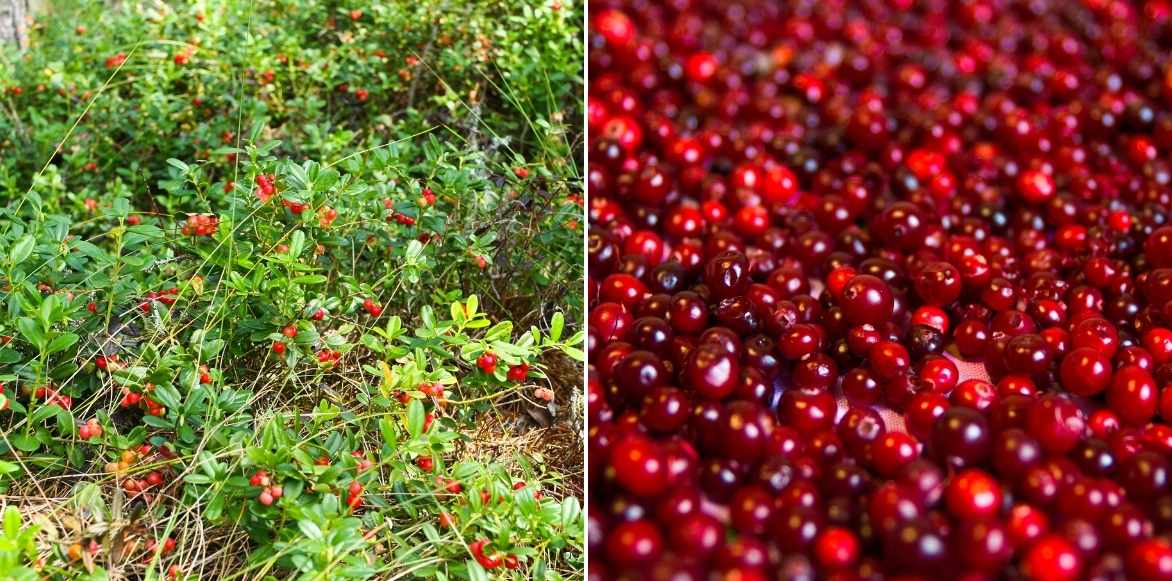
Cranberry: bush and berries
Description and Botany
Botanical data
- Latin name Vaccinium macrocarpon
- Family Ericaceae
- Common name Cranberry
- Flowering June-July
- Height 0.30 to 0.45 m
- Exposure partial shade
- Soil type acidic, moist
- Hardiness –15 °C
Cranberry (Vaccinium macrocarpon) is a shrub belonging to the Ericaceae family, which includes heathers and rhododendrons. It is part of the genus Vaccinium, alongside the blueberry (Vaccinium corymbosum) and the bilberry, with which it is often confused. It naturally grows in the acidic peat bogs of the northern United States.
The majority of cranberry production comes from North America, particularly Wisconsin and Massachusetts. In Quebec, where it is also widely cultivated, it is called “canneberge”, while in America, this small fruit tree is referred to as “cranberry” or “Large Red Berry of North America”. The Vaccinium macrocarpon, the American cranberry with large fruits, is the only cultivated species. It has produced several productive and vigorous varieties such as ‘Pilgrim’ and ‘Early Black’, an early variety offering dark red berries. There is another species, European and wild this time, Vaccinium oxycoccos, which is smaller and can be found, for example, in the northern half of France.
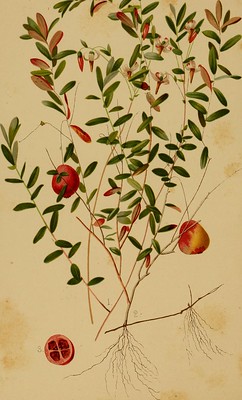
Vaccinium macrocarpon, botanical plate from 1879
Cranberry forms a groundcover shrub with a bushy habit, remaining small in size. With a rather slow growth rate, this bush does not exceed 30 cm in height and 60 cm in width. The plant easily roots in the soil through its fine creeping branches that root spontaneously. These stolons can extend up to 80 cm.
The cranberry develops small, dark green, evergreen leaves that are oval and pointed, sometimes turning bronze in autumn.
Flowering occurs in summer, in June-July, with small pink to pale pink flowers about 1 cm long. They are borne on long peduncles and bloom in well-opened corollas along the stems. The plant derives its vernacular name meaning “Crane Berry” due to the shape of its flowers resembling a crane’s head.
Then, the flowers turn into small round red fruits about 2 cm in diameter. These small fleshy berries are black in blueberries. They reach ripeness in autumn, with the first harvest appearing from the fourth year of cultivation. Cranberries are firm and sweet, with a pleasantly tart, astringent flavour.
The intensive cultivation of cranberries is quite complex, as it requires significant amounts of water. They are grown in sandy basins surrounded by dikes called “cranberry bogs” to carry out what is known as a wet harvest. To harvest them, these fields are flooded, and the cranberry plants are agitated to retrieve the ripe fruits: these then float to the surface of the water and can be collected more easily.

Foliage, fruits, and flowers of the cranberry
Read also
How to protect fruit trees from birds?Main species and varieties
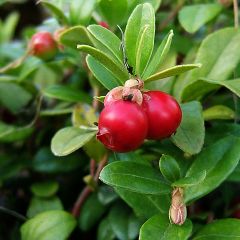
Cranberry - Vaccinium macrocarpon
- Période de floraison July, August
- Hauteur 30 cm
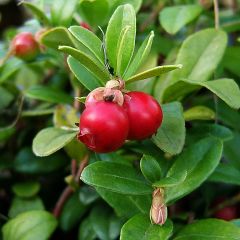
Vaccinium macrocarpon Pilgrim - Cranberry
- Période de floraison July, August
- Hauteur 30 cm
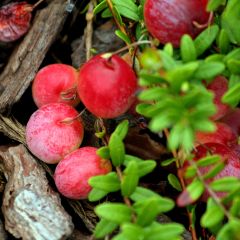
Vaccinium Early Black - Cranberry
- Période de floraison July, August
- Hauteur 30 cm
Cranberry planting
Where to plant it?
Cranberry is hardy and has good cold resistance down to -15°C, with a particularly long lifespan of nearly a hundred years. However, be cautious of late frosts that could damage the flowering.
It can be planted in all our regions, except in the south of the country where it is too hot in summer. It is a very water-hungry plant, it does not like arid climates and must never suffer from drought.
Not tolerating limestone, it should be planted in acidic soil with a pH between 4 and 5 and very moist. This bush should be planted in partial shade in cool, organic-rich, well-drained soil. The soil must remain cool but not waterlogged. In case of limestone soil, it is preferable to plant in a pot.
It can be planted in the ground in the garden or orchard, to create small fruit hedges or to enhance a heather soil bed.
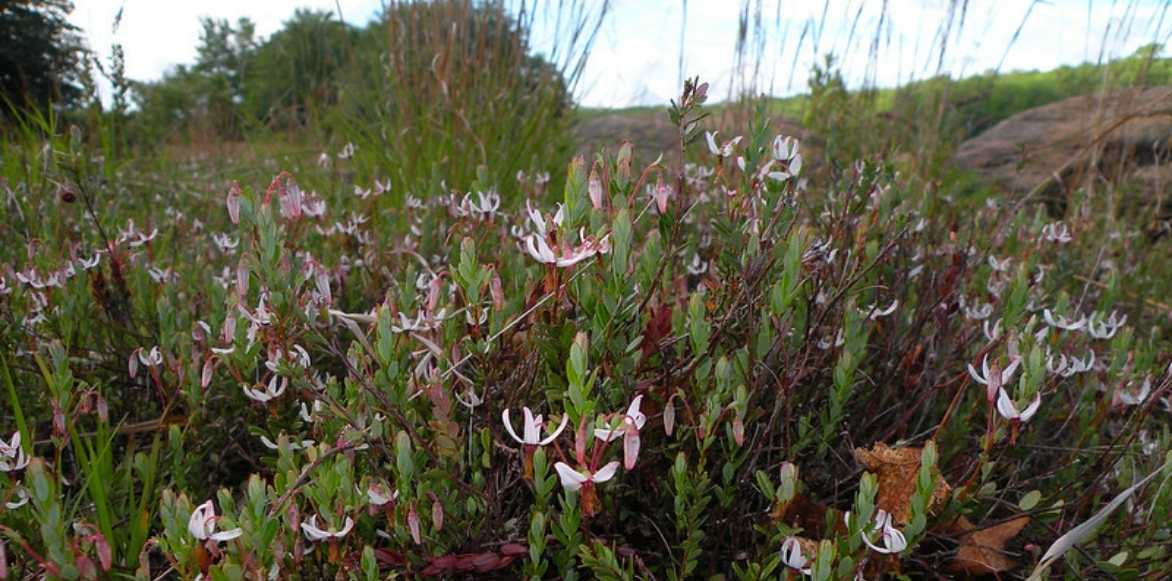
Vaccinium macrocarpon (© Doug McGrady)
When to plant it?
Cranberry planting ideally takes place in autumn so that it can establish well before winter.
How to plant it?
Even though it is self-fertile, a single plant will not produce fruit; for good pollination, it is advisable to plant at least 2 to 3 cranberry plants of the same variety or different varieties (Aurélien explains everything about pollination of fruit trees).
In the ground
If you are planting several plants, space them 60-70 cm apart. Plant in non-limestone soil composed of pure heather soil or a mixture of ordinary soil and peat, and well-decomposed bark compost.
- Dig a hole 50 to 60 cm deep and 80 cm wide
- Place the root ball in the centre of the hole: the collar should be level with the soil
- Fill with pure heather soil or a mixture of ordinary soil and peat, and well-decomposed bark compost
- Firm down well and water generously
For more tips, see our article “Planting an unusual fruit hedge!”
In a pot
Pot cultivation is entirely possible by respecting the same type of substrate and exposure conditions. You should choose a large, very deep container with drainage holes (30 or 40 cm).
- Place a layer of clay balls at the bottom to promote drainage
- Plant in pure heather soil or in a mixture of garden soil and blonde and brown peat
- Firm down well
- Water
Growing, care and pruning
Cranberries grow slowly but surely, provided that water supply is monitored in both summer and winter. Water preferably with non-limestone water (such as rainwater). In both soil and pots, the soil must never dry out completely between waterings. In pots, be even more vigilant about watering. Mulch the base with shredded bark or fern leaves to maintain moisture and a certain acidity in the soil. In spring, top up with a bit of turf and some sand each year.
Pruning consists of maintenance pruning to balance or densify the habit: using pruning shears, lightly trim the shoots and remove any weak or diseased branches. During the first few years, allow the bush to grow naturally. After five years of cultivation, you can cut the plants back to 10 cm from the ground every three years, at the very beginning of spring, to rejuvenate them.
In our latitudes, cranberries are not threatened by the cranberry borer.
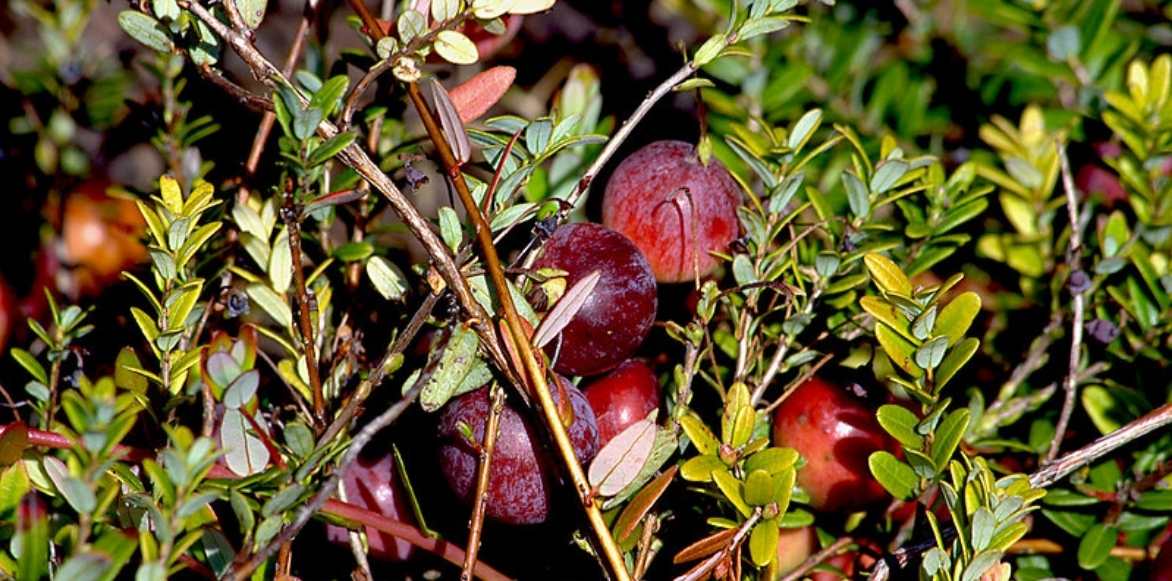
Vaccinium macrocarpon (© Manuel mv)
Harvest, storage, benefits of cranberries
When and how to harvest?
The harvest of cranberries takes place in autumn, in October-November, when their skin is a deep red. However, it can extend for several months during winter, as the berries remain on the stems even after a snowfall. A plant will yield about 300 g of cranberries under good conditions, after approximately five years of planting.
Storage
Cranberries can be stored fresh; once picked, they keep quite well, so keep them in the vegetable drawer of the refrigerator for a few days. They can also be dried or frozen for longer storage.
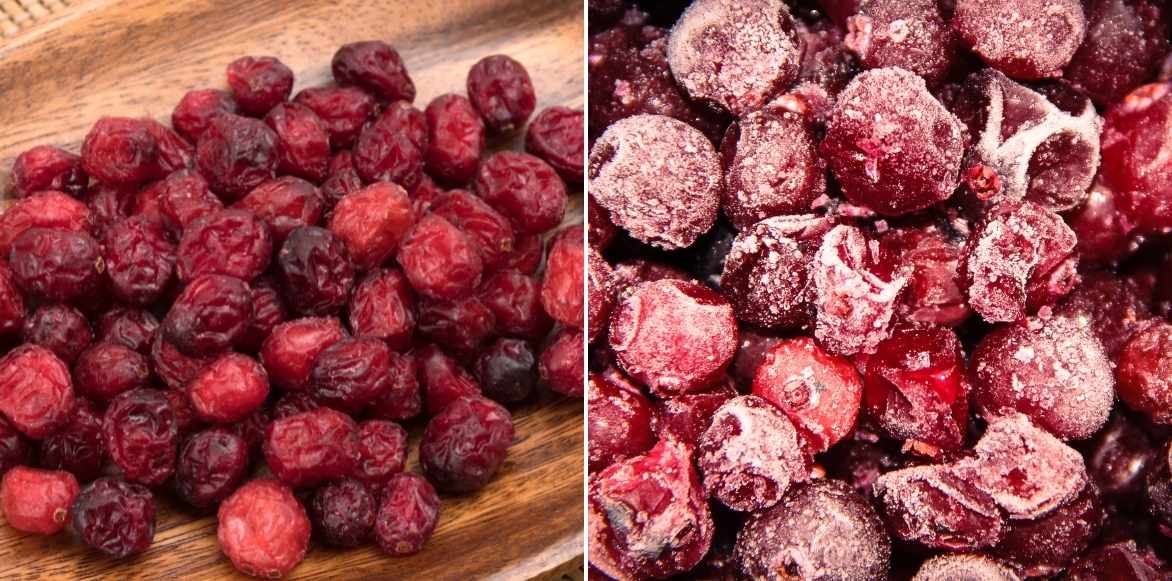 Drying, as well as freezing, allows you to use cranberries as needed.
Drying, as well as freezing, allows you to use cranberries as needed.
Uses of cranberries
Cranberries can be consumed fresh, cooked, or dried. They are used in juice. These small, quite acidic berries lend themselves to many recipes: cranberries are ideal for making jams, accompanying meats and game, in chutney, or in sauce as Canadians do to enhance Christmas meals. They pair perfectly with cooked red cabbage. They also add a sweet and tangy note to salads and combine wonderfully with fresh goat cheese or Greek yogurt as a substitute for raisins. They integrate very well into muffins, cookies, or brownies. Like goji berries, when dried, they can simply be snacked on alone or mixed with other berries and seeds.
→ Read more: How to prepare a wellness tea with cranberries?
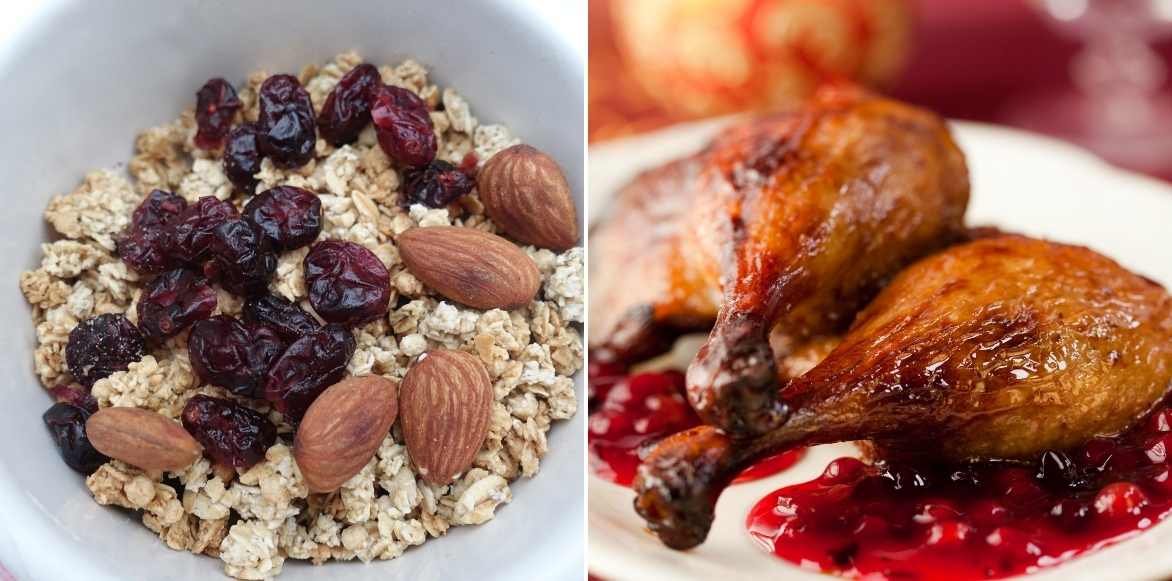 In cooking, cranberry berries can be added to muesli; they pair wonderfully with duck!
In cooking, cranberry berries can be added to muesli; they pair wonderfully with duck!
Benefits
It is a fruit rich in vitamin C and antioxidants. Cranberry juice is recommended as a natural remedy, in juice or capsule form, against urinary infections.
Multiplication
Cranberry multiplies easily by layering, by propagation by cuttings of semi-woody stems in summer, or by division of well-established plants.
By layering
If cranberry stems layer naturally, you can multiply the plants by burying the runners in the soil, then separating them from the parent plant once they have developed sufficient roots. Replant in the garden in well-prepared soil.
Taking cuttings
- At the end of summer, take semi-ripe cuttings 10-20 cm long (when the shoots begin to turn into hardwood)
- Remove the lower leaves and leave a few leaves at the tips of the stems
- Plant the cuttings in pots containing a mixture of potting soil and turf kept slightly moist
- Overwinter the cuttings in a frost-free environment
- Regularly moisten the cuttings
- Transplant into the ground the following spring
By division of clumps
- In autumn, using a sharp spade, lift a nice mature clump and take divisions that include rooted lateral runners
- Replant immediately in a planting hole
- Backfill with heather soil
- Firm down and mulch
- Water generously and keep the soil moist to encourage establishment
- Curious and gourmet gardeners, discover all our original and exotic fruit trees!
- Discover our ideas: “Planting a fruit hedge… that stands out!”
- All the tips for beautiful fruit trees are on our blog
- Discover our wide range of fruit trees, from the most classic to the most original and exotic!
- Learn more with Pascale on the blog: Growing superfruits is possible
- Subscribe!
- Contents































Comments